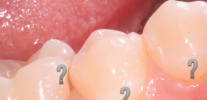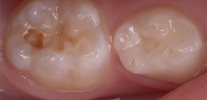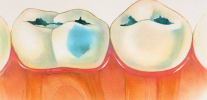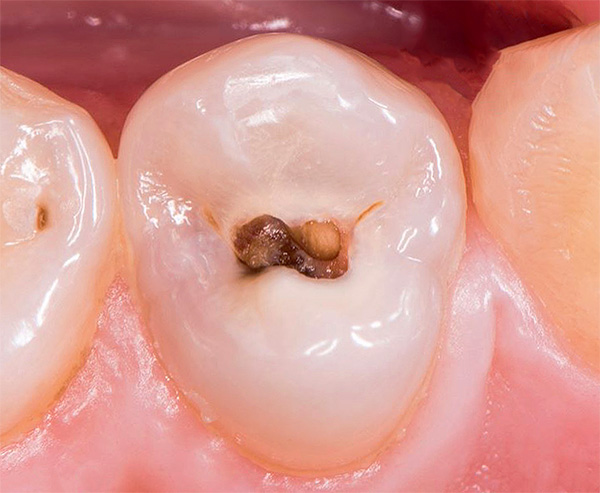
According to statistics, it is the average caries, as diagnosed, found in the practice of the dentist most often. Despite the seemingly seemingly insignificant pathology and its “average” severity, it can lead to very serious problems (if necessary measures are not taken in time).
For a better understanding of the fact that the process is already quite running, it is useful to have an idea about the conditionally distinguished stages of caries, which happens:
- Initial (sometimes they say about the stage of white or chalk spots - at this stage only some demineralization of tooth enamel occurs);
- Superficial (tooth enamel collapses);
- Middle (this is already the active destruction of the dentin, which is under the protective tooth enamel);
- Deep (pathological process closely approaches the pulp chamber of the tooth).
If the first two forms are sometimes difficult to diagnose and are often similar to the usual congenital pigmentation on the teeth, which does not lead to any negative consequences, then the average caries is almost always easy to identify.
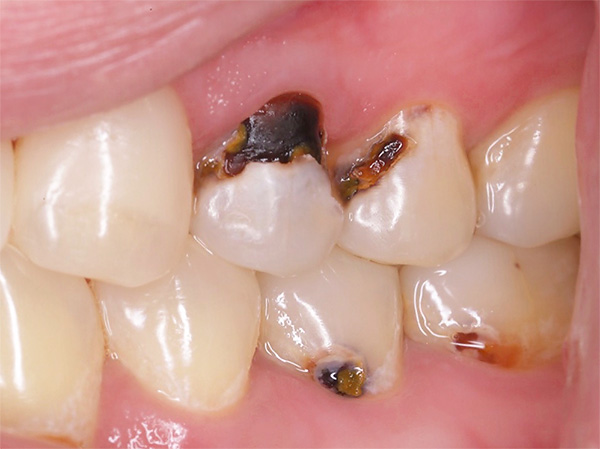
On a note
Often, in the initial stage, caries can be in a compensated form (in a “sleeping” state) for more than 5-10 years, practically not developing further and without causing problems. While average caries is usually not chronic: as a rule, the pathology progresses rather quickly, the carious cavity deepens and expands. As a result, as the first consequence (and not the most dangerous), pulpitis of the tooth develops, which is characterized by severe pains.
It turns out that the patient often comes to the dentist only when there are clearly tangible problems on the teeth. Fortunately, not everything is so bad - the average caries, taking into account the specificity and depth of tissue damage, is exactly the form when you can:
- To accurately determine its localization (except for specific situations). That is, in most cases, it is possible to correlate the symptoms of a patient with a particular tooth during an examination at the dentist;
- To preserve the tooth tissue as much as possible (preparation of a drill is carried out at a relatively small depth);
- It is painless and with minimal time costs to put a seal or to conduct high-quality artistic restoration of the front tooth in one visit;
- To carry out treatment with minimal financial costs on the part of the patient (in comparison with the complications of caries - pulpitis or periodontitis, the treatment of which can cost up to 10 times more). In addition, the treatment of average caries, in contrast, for example, from deep, usually eliminates the use of medical pads, as well as unnecessary visits to the dentist.
The photo below shows the average caries localized in the fissure (hole) of the molars:

On a note
When tooth preparation is required, the treatment of any degree of caries neglect is accompanied by the use of air-water cooling, but not all clinics have its level perfect. That is why the "drilling" of a tooth with deep caries is fraught with overheating of the nearby pulp (the so-called "nerve"). With an average caries, the use of cooling is also mandatory, but the risks of pulpitis after such treatment are practically reduced to zero due to the shallow cavity.
Preserving a tooth with a lively healthy pulp is the most preferable solution, in contrast to the expensive intra-canal treatment, which is almost always carried out in a few visits.In addition, a “dead” tooth (without pulp) may darken over time, become brittle and significantly less resistant to stress. Therefore, it is better not to delay and carry out a planned reorganization (complete elimination of carious lesions) at the first signs of a carious process.
The main signs of average caries: how to identify the problem in time
If the initial and superficial forms of caries most often go unnoticed, then the average caries can be easily identified even at home.
Here is an example of the start of a standard medical history:
"The patient complained of recurrent pains from sweet and cold, which first arose two days ago from the moment of treatment ..."
What diagnosis will the dentist first suspect? Of course, the average caries, as the most common pathology for such symptoms: any irritant, hitting a naked dentin, can cause short-term pain. Irritation of the nerve endings of the dentin can be chemical (salty, sweet, sour), mechanical (solid food) and temperature (cold, hot). Visually, a shallow carious defect, usually of a dark color and irregular shape, is determined on the tooth.
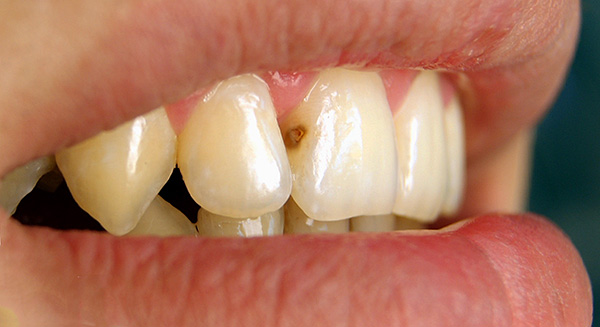
On a note
At home, such defects can not always be correctly identified - they can look like grayish or brown spots, dots, grooves. If such a defect is in the interdental gap, then it can be difficult to notice. Defects on the lower small and large molars are clearly visible (hereinafter the example is shown in the photo).
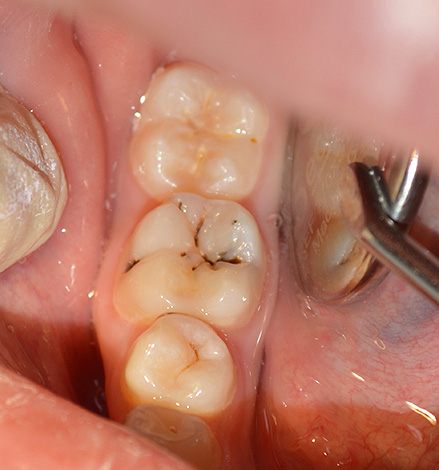
Sometimes complaints of pain may be completely absent, but the appearance of carious spots changes for the worse with each passing month - and this is a 100% indicator not of a congenital, but an acquired defect, that is, caries. Only a dentist will be able to clarify the stage of the carious process by collecting additional information: specifying the medical history, examining the oral cavity, probing the carious tooth. Sometimes instrumental methods of research (X-ray diagnostics, EDI) can also be used.
From the practice of the dentist
At the time of diagnosis, the coincidence of symptoms in a patient with a clinical picture in the oral cavity is crucial. If the complaints relate to acute and (or) long aching pains - spontaneous, or for a long time not passing from the above listed stimuli - then almost 100% are already talking about the complication of caries (pulpitis or periodontitis).It does not matter if in the past there were such pains, or they are forced to “climb on the wall” at the given moment of time, and also it doesn’t matter whether there is a large carious cavity, or barely noticeable.
On the contrary, if the patient focuses only on the recently appeared minor and short-term pain from irritants, and a well-defined deep carious cavity takes place on the tooth, then, despite the symptoms, the doctor treats no longer average, but deep caries, or (if necessary) intracanal tooth treatment.
Today, the main diagnostic methods are sensing, EDI (electrical donor diagnostics) and X-ray diagnostics. When probing an average caries, the acute probe gets “stuck” in the carious cavity, and the patient often reports about the appearance of pain when the probe is applied to the enamel-dentinal boundary. Indicators of EDI in this case range from 2 to 6 μA, and on the X-ray photograph, the carious cavity is defined to be of an insignificant depth.
And what, in fact, happens to the tooth during carious destruction?
Under certain conditions, long before carious tooth decay becomes visually well noticeable, the processes that trigger the mechanism of "decay" of the tooth begin.The speed of these processes depends on many factors.
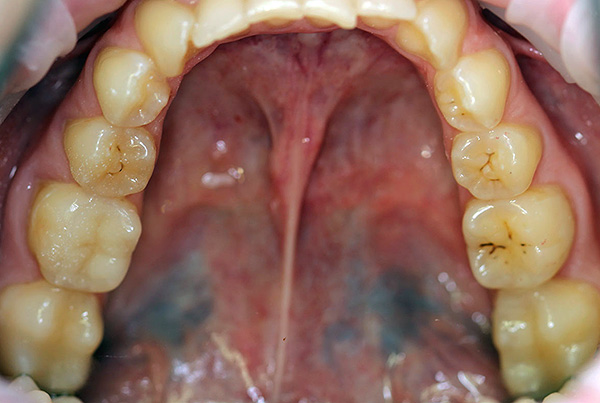
In addition to the genetically determined structure of enamel, there are also general and local factors that directly affect dental health.
Here is a simple example: a person's entire life was fine with his teeth, but suddenly, for some reason or other, the disease xerostomia (reduced salivation) develops. And literally over the next few months, multiple caries develops on the teeth - from the initial to the intermediate and deep stages. The reason in this case is that saliva (which is often called “liquid tooth enamel”), containing a complex of mineral components that are very important for the health of teeth, has ceased to come into tooth enamel. In other words, the balance was disturbed, and the teeth quickly "fell down."
As a rule, the development of caries is not complete without the main local cause of focal demineralization - this is caused by carbohydrates and dental plaque (this combination releases organic acids on the enamel surface, which dissolve its crystal lattice). It should be borne in mind that plaque is formed within a few hours after brushing your teeth, and carbohydrates absorbed (especially in large doses) are the favorite food of bacteria,mainly from the group Streptococcus mutans. Biological transformation of sugars in plaque triggers the introduction of organic acids (lactic, pyruvic, etc.) into the surface layers of enamel with the formation of a focal demineralization site.
Focal demineralization of enamel - this is the initial caries, which visually begins to be determined in the form of a matte, white or already slightly pigmented spot on the tooth surface.
The photo shows an example of caries in the stage of white spots on the child’s front teeth:

It is this stage of the carious process that can be reversible with a timely launched complex of recovery procedures - remineralization and fluoridation. With further softening of the enamel, its structure is irreversibly destroyed, surface caries is formed, and over time, the bacteria begin to destroy and dentine.
At the stage of average caries, as a rule, there is a fairly rapid destruction of the dentin, the porous structure of which is filled with many carious bacteria. However, the most severe and neglected form of caries is the deep form, when, against the background of the rapid destruction of the structure of the dentin, a deep carious cavity is formed. At the same time, only a few millimeters (often even fractions of a millimeter) remain up to the pulp, and the bottom of the cavity is covered with softened, pigmented, decaying tooth tissues. Personal deep caries is most dangerous from the point of view of transition to a more serious disease - pulpitis.
This is how deep caries looks like:
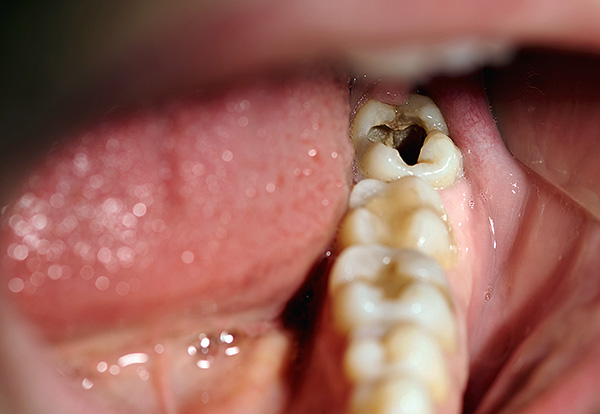
It is interesting
There is a myth that one bad tooth can “infect” nearby neighbors with caries. This erroneous idea is inspired by the fact that in the treatment of one tooth on the adjacent one also often a carious lesion is found.
In fact, caries is an exclusively local pathological process. During the use of easily fermentable carbohydrates, the gaps between the teeth are literally clogged remnants of food. And since the culture of cleaning dental gaps in Russia has not yet taken root sufficiently, the tooth wall begins to dissolve with the appearance of even larger cavities for food retention. At the same time, the adjacent wall, even taking into account the initially normal mineral structure, with such a frank “food dump” begins to deteriorate.
By the way, this is why people with large gaps between their teeth most often do not have caries on the side walls. Well, those who regularly and correctly use dental floss or irrigators in addition to brushes.
How can I quickly remove pain without resorting to pills
The average caries may be asymptomatic, but in most cases there are characteristic clinical manifestations of the disease. If even short-term pains from sweet, hot and (or) cold appear, it is important to seek the help of a dentist as quickly as possible in order not to bring the matter to pulpitis.
If in a private clinic they can still meet, making an appointment as soon as possible, they can put in a queue in a budget institution: for a week or even a month depending on the workload of the dentist. This is especially characteristic of receiving by OMS (that is, free of charge).
In other words, most people with a bad tooth will need to wait some time before visiting a doctor. Let's look at how pain can be reduced during this time, so that you feel as comfortable as possible before visiting the doctor.
With an average caries, the pains can be short-lived, but sometimes quite strong. The classic of the “genre” is the ingestion of a sweet candy (for example, toffee) in the fissures (pits) of a chewing tooth. In this case, we are talking about the appearance of pain from the sweet, which is eliminated by the rapid removal of the stimulus: when rinsing the mouth with warm water, sugars are evacuated from the area of the carious defect, and the pain passes instantly.

On a note
With deep caries, the closure of the carious cavity with a piece of fleece helps and its periodic replacement several times a day.
With regular pain from cold and hot, the only way out is to abstain from cold and hot food and drinks (before treatment). To take pain pills in such a situation is inappropriate.
It is interesting
Carious defect can be localized not only on the chewing surface of molars and premolars, but also in the cervical area - near the gum, or even slightly below it. Hence it is also important to remove food irritants, so as not to provoke the appearance of pain.
In addition, as noted above, carious cavities are often present on the contact surfaces of teeth (in other words, between teeth, where the brush does not penetrate).And in some cases it turns out that a person may experience long-term pain, because he does not know to clear the tooth gap from the “debris”, which can be candy, meat, and gingerbread. To quickly relieve pain, it is enough to use toothpicks, floss, special brushes or irrigator.
What can threaten the average caries, if delayed with the treatment of the tooth
It should be understood that the average caries already corresponds to the irreversible destruction of the tooth tissues (these tissues can not be restored, but you can only put a seal, which to some extent will replace them). Whenever a tooth is prepared, it is weakened - sometimes slightly, and sometimes to a significant extent. And the longer the treatment is delayed, the greater will be the carious cavity, the more necrotic tissue the doctor will have to excise and the weaker the walls of the tooth may be.
If, however, time does not go into treatment, then usually caries first leads to the formation of a deep defect with the subsequent penetration of infection into the pulp chamber, where it will cause inflammation of the neurovascular bundle. The result is pulpitis or periodontitis.Most often, the sequence is as follows: first, pulpitis occurs in the tooth with acute spontaneous pain, and after some time the pain disappears - the dental “nerve” dies, and an inflammation center is formed on the root of the tooth (periodontitis).
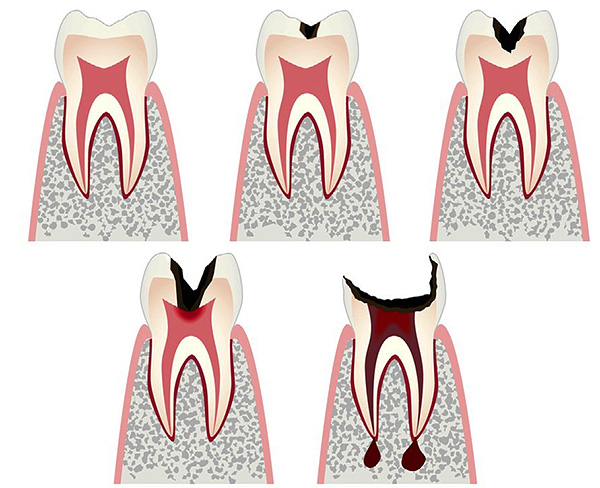
The periods of transition of the average caries into the pulpitis are individual. It is quite possible to fall into the category of “lucky ones” (and these are found in the practice of the dentist), when all stages of tooth decay are either asymptomatic or with little or no pain. After some time, only a rotten dead tooth with pus bags on the roots (cysts) remains in the mouth - as a rule, the doctor can only offer its removal.
There are also a lot of examples when for several months an untreated caries turns into a form of pulpitis, in which the patient can literally take handfuls of pain pills, but they do not help him. And even if the pulpitis turns into periodontitis, it still does not mean a reduction in pain. Periodontitis is often a purulent process, when the face becomes asymmetrical, and at best pus is secreted through the fistula in the mouth, and at worst is under the gum near the decayed tooth, which is accompanied by intense pulsating pain, which increases with biting on the tooth.
The photo below shows a fistula on the gum above the “dead” front tooth:
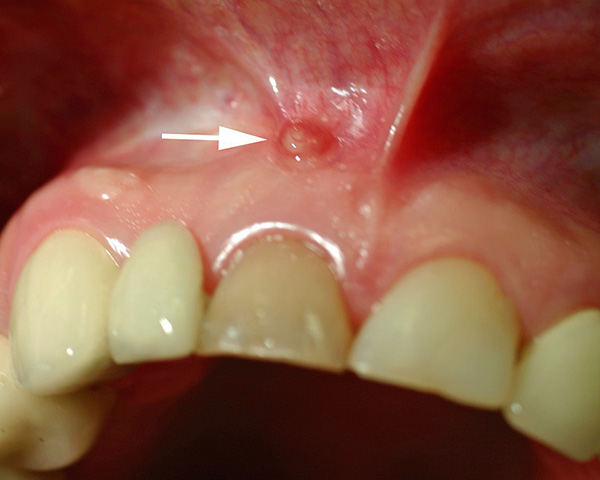
From the practice of the dentist
It is very difficult to anesthetize such patients in the place where the purulent exudate is located. It is often necessary to take several approaches in order to introduce an anesthetic solution at least a little, since the near-root region simply physically does not contain excess liquid. That is why a number of dentists are limited during the first visit only to a cut through the transition fold, so that the next visit can deal with more comfortable conditions during treatment (first of all, for the patient).
In addition to pulpitis and periodontitis, there are other negative effects. In particular, a carious infection may ultimately have a negative effect on overall health:
- Undermining immunity;
- Provoking cardiovascular diseases;
- Initiating inflammatory processes in the joints.
Separately, it should be said about a serious mistake of parents who deliberately do not treat caries on baby teeth in children, guided by the following principles:
- If it hurts a lot, then we will treat or pull it out - all the same, because baby teeth will fall out;
- Why treat baby teeth, if they are replaced by permanent ones.
Unfortunately, these principles are still followed by a huge number of people, thus putting the health of their children at risk (and this is not only about dental health). The fact is that in children with baby teeth, the stages of caries “fly through” in a matter of weeks, and a tooth within 1-2 months may become a threat of the spread of infection throughout the body. In this case, purulent infection may be irreversibly damaged and the primordia of permanent teeth, which were never destined to cut through.
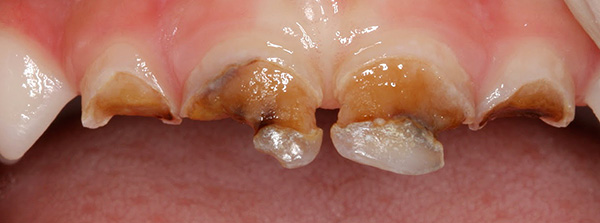
Early treatment of initial, medium or deep caries of milk teeth in children's dentistry will not only protect the germ of a permanent tooth from the negative effects of infection, but also save the child from difficult moments of difficult treatment when acute pain occurs, from premature removal, and in some cases from cellulitis, sepsis and other life-threatening odontogenic complications.
What awaits you in the dentist's office: the stages of treatment of average caries
When the doctor makes a diagnosis of “average caries” (or, in the case of ICD-10 designation, “dentine caries”), treatment is usually carried out in one visit.
In this case, perhaps, the most burning question that interests the patients - and how painful will the procedure be? So, it all depends on the specific clinical situation - in some cases, an injection of anesthetic before the treatment of caries may not be done.
Previously (in Soviet dentistry) this question was almost always solved by a doctor. As a result, many people have even formed a certain stereotype that anesthesia is done only to remove a tooth or when removing a “nerve”. Now everything has changed radically: often patients, experiencing panic fear of an injection, ask the dentist to treat middle caries without anesthesia; or, on the contrary, they ask to be sure to put an injection, even if the minimum use of a dental drill is to be.
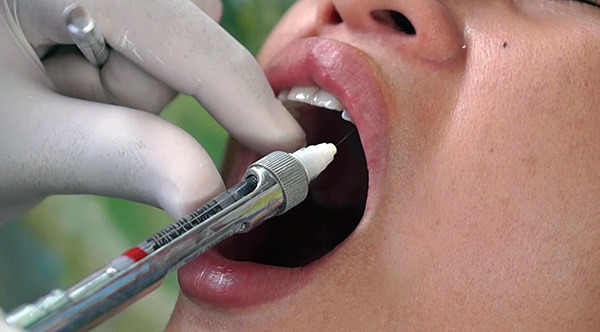
On a note
Since modern dental units are equipped with air-water cooling with minimal parameters of tip vibrations, then in about half of the cases, even without anesthesia, during tooth preparation, with average caries, pain will not occur.
Can I choose anesthesia in the treatment of caries?
General anesthesia (anesthesia) is practically not used in the treatment of caries (with rare exceptions, when there are a number of indications - for example, intolerance to local anesthetics, a pronounced gag reflex that interferes with manipulation, panic fear in front of any dental manipulation). Choosing anesthesia only from a whim carries many more risks, rather than using local anesthesia.
Sedation is most often used when the patient is conscious and able to carry out the instructions of the doctor, but at the same time remains in a relaxed state (the use of sedation in children's dentistry is especially important).
We have dealt with anesthesia (this is the first stage) - now we will proceed to the consideration of further stages of caries treatment:
- Tooth preparation. In other words, it is cleansing it from "caries", that is, those tissues that are softened and infected. These are darkened (black) enamel, softened and pigmented dentin, etc. It is the quality of this step that determines whether caries will continue under the filling or not. If the doctor did not care to clean the cavity of all that was superfluous,then after a while you can observe a darkening under the filling and around it, loss of filling, and in more serious cases - the development of pulpitis or periodontitis;
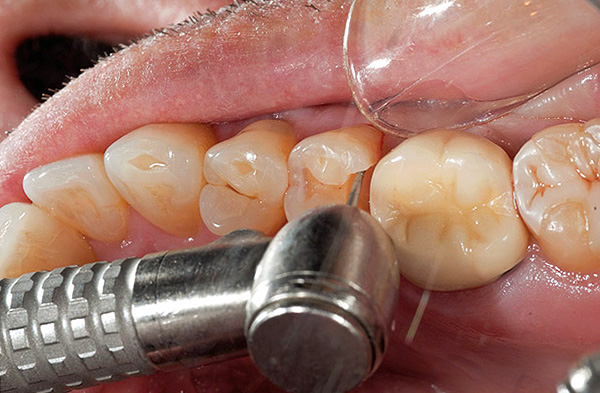
- Medical treatment of the prepared cavity. This is an important stage in the final design of the cavity for a future filling, which involves the medical treatment of the bottom and walls with antiseptics. One of the most popular currently is a 2% aqueous solution of chlorhexidine and preparations based on it ("Consepsis", for example), compatible with modern light-cured composite materials;
- The introduction of an insulating gasket under the seal. This stage is relevant only when using filling materials, having in its composition components that act aggressively on the pulp of the tooth. At present, in connection with the use of modern technologies of sealing with “light” materials, in compliance with the protocols of working with adhesive systems, laying (lining) is not required. Adhesive systems are special adhesives that allow you to join dissimilar materials;
- The final stage in the treatment of caries - staging fillings (filling) or aesthetic restoration.
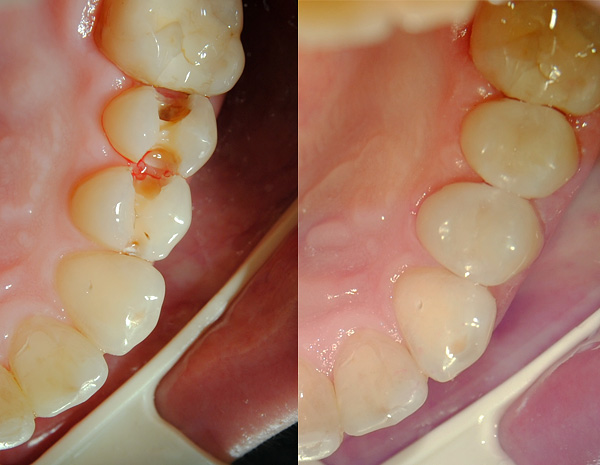
On a note
Here it is worth saying a few words about the difference between filling and aesthetic restoration. When it comes to staging fillings, they mean materials or technology that do not allow sufficient restoration of a lost aesthetics of a tooth. First of all, this refers to the seals, which should not be made in layers, that is, work with them proceeds according to the principle: they have mixed it - they have brought it into the cavity - they have waited, and when it hardens - it has been polished. If one can somehow return the function with such materials (cements, amalgams, chemical composites), then aesthetics and the original form cannot be restored.
It is possible to restore the unique shape and color of the tooth only by light-cured composites suitable for restoration. Especially valuable are materials for artistic restoration. It is artistic restoration that allows to form all the unique aspects of the shape and color characteristics of a tooth so that it cannot be distinguished from its native tooth, even on closer examination. Often such works are copyrighted, and such treatment of caries requires a lot of time.
What influences the cost of treatment
From the point of view of logic and common sense, the price for the treatment of caries should consist of the cost of the materials spent (anesthesia, filling material, etc.) and the cost of the service.

In public institutions for free admission there are no such categories, but often there is also no interest of the doctor in doing quality work, nor the materials that are necessary for this. The exceptions are those cases when materials and preparations are used that are not included in the category of OMS and allow the doctor to receive his percentage of the work performed, and the patient to have a guarantee for this service in the form of a receipt.

In private clinics, the price for dental treatment is sometimes unpredictable, and it is absolutely impossible to guess how the final cost is formed for a person far from medicine. Moreover, even the doctors of neighboring clinics sometimes cannot understand all the intricacies of pricing a particular organization.

In addition to the quality of materials for fillings and anesthesia (cheaper-more expensive), there are a number of items that also affect the charging. For example:
- The class of carious defect according to Black.Depending on the location of the carious cavity and the configuration of the affected area, the price is determined for each class, since the treatment in some cases is much more complicated and requires additional materials and time;
- The number of restored tooth surfaces. Many clinics even treat the treatment of average caries not only by classes of carious cavities, but also take into account the number of tooth surfaces with which you have to work. For example, if the contact surface of a molar is destroyed, the price for the second class according to Bleck is one, and if the treatment involves not only the front, but also the posterior surface of the tooth, then the clinic may request an additional seal separately;
- The use of gaskets under the seal. The introduction of an insulating gasket prior to the placement of a seal can also affect the cost of treatment;
- Additional manipulations. For example, quite often in the price lists of clinics one can observe that individual categories use laser for preparing teeth, ultrasonic antiseptic treatment for increasing sterility, grinding and filling of fillings, etc.
In addition, the higher the status of the clinic, the level of organization and equipment, and the higher the professionalism and (or) the greater the number of diplomas (certificates) from a dentist, the higher the price for treatment will be on average.
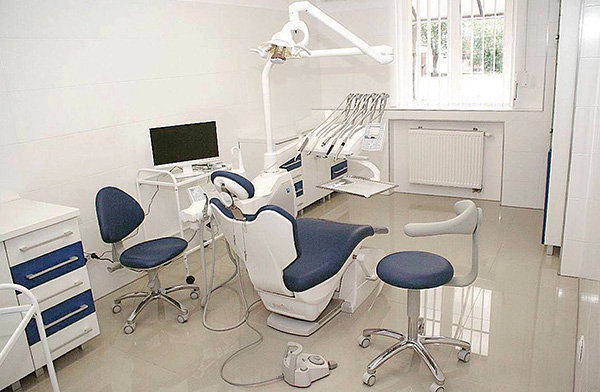
It should also be noted that the cost of dental services in different regions of Russia is significantly different - according to the levels of financial well-being of the population. For example, in Moscow, an ideally performed treatment of an average caries can cost 3–4 thousand rubles, while in Voronezh or Izhevsk the cost of the same procedures can be 1500–2000 rubles. If you treat a lot of teeth, it turns out a decent savings. Therefore, there is such a phenomenon as dental tourism.
From the practice of the dentist
Many people mistakenly believe that the quality of work is almost 100% determined by the quality (cost) of the filling material. In fact, the lion’s share of treatment success depends primarily on the skill of the doctor, working conditions and suitable equipment. You can explain it by a clear example from practice.
An aunt is working in the state hospital, which for a fee puts Filtek (Filtek) - one of the best and most expensive materials.At the same time, it fits into 15–20 minutes of allotted time per patient per reception (this is very little). As a result, the patient receives a seal of excellent material with carious tissues left under it (the doctor simply does not have time for each patient to clean everything thoroughly). And then someone as lucky: someone has a seal lasts longer, someone less. So patients go - they change it year after year. And in the next private office, one uncle slowly puts seals, which are cheaper to purchase than Filtek from the Gluma Comfort Bond Charisma. At the same time, the fillings are perfectly kept, and the tooth under them does not deteriorate and does not hurt, as in the first case.
If you have a personal experience of “dating” with caries - be sure to share your impressions by leaving your review at the bottom of this page. How bad is the situation and are you going to treat your teeth? Does the caries cause any inconvenience, or does not manifest itself? Thousands of people are in the same situation, and perhaps this information will be useful to them.
Interesting video with a good example of caries treatment on the lower chewing teeth: all stages of the process are shown
It turns out that caries can become infected?

